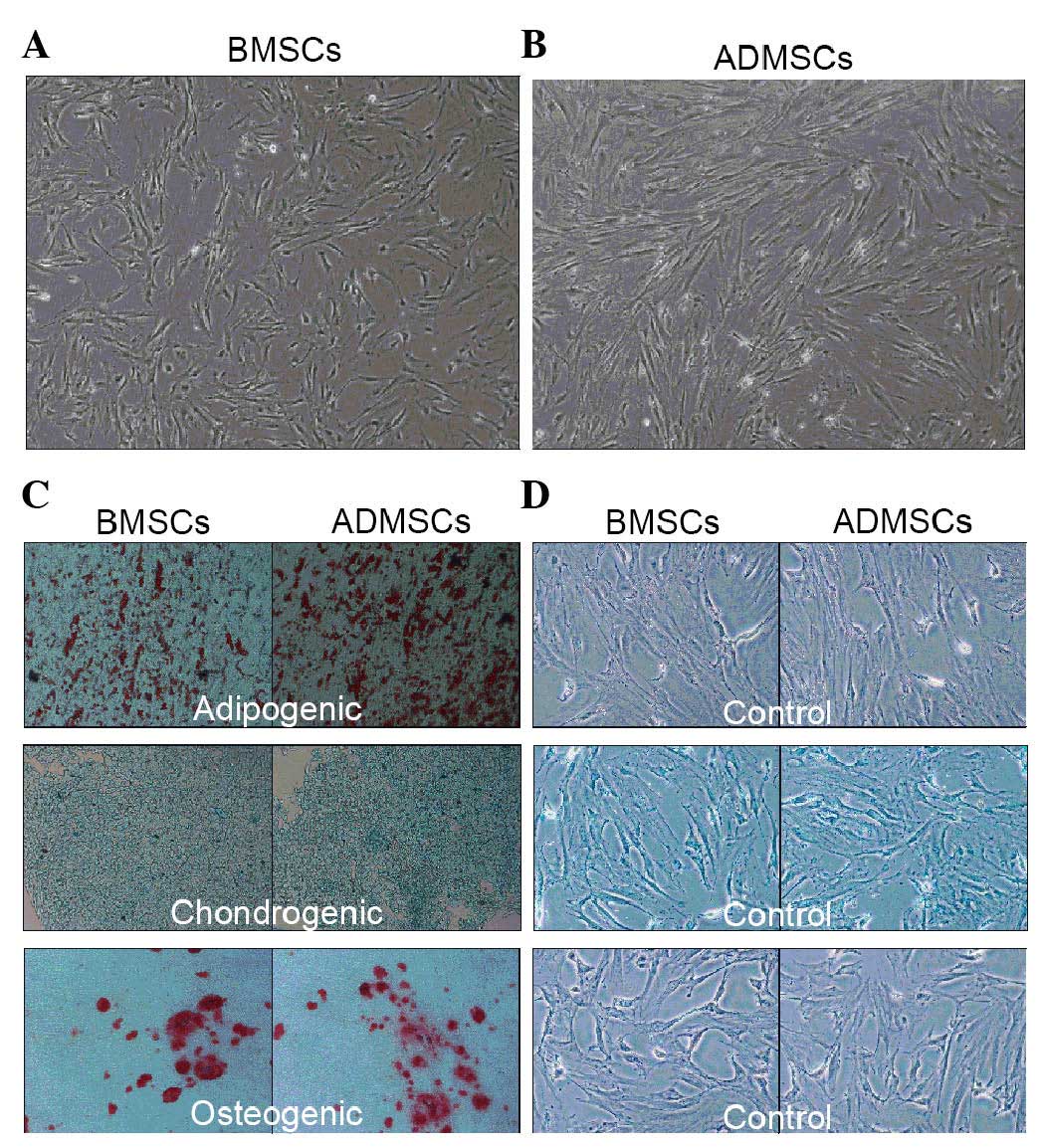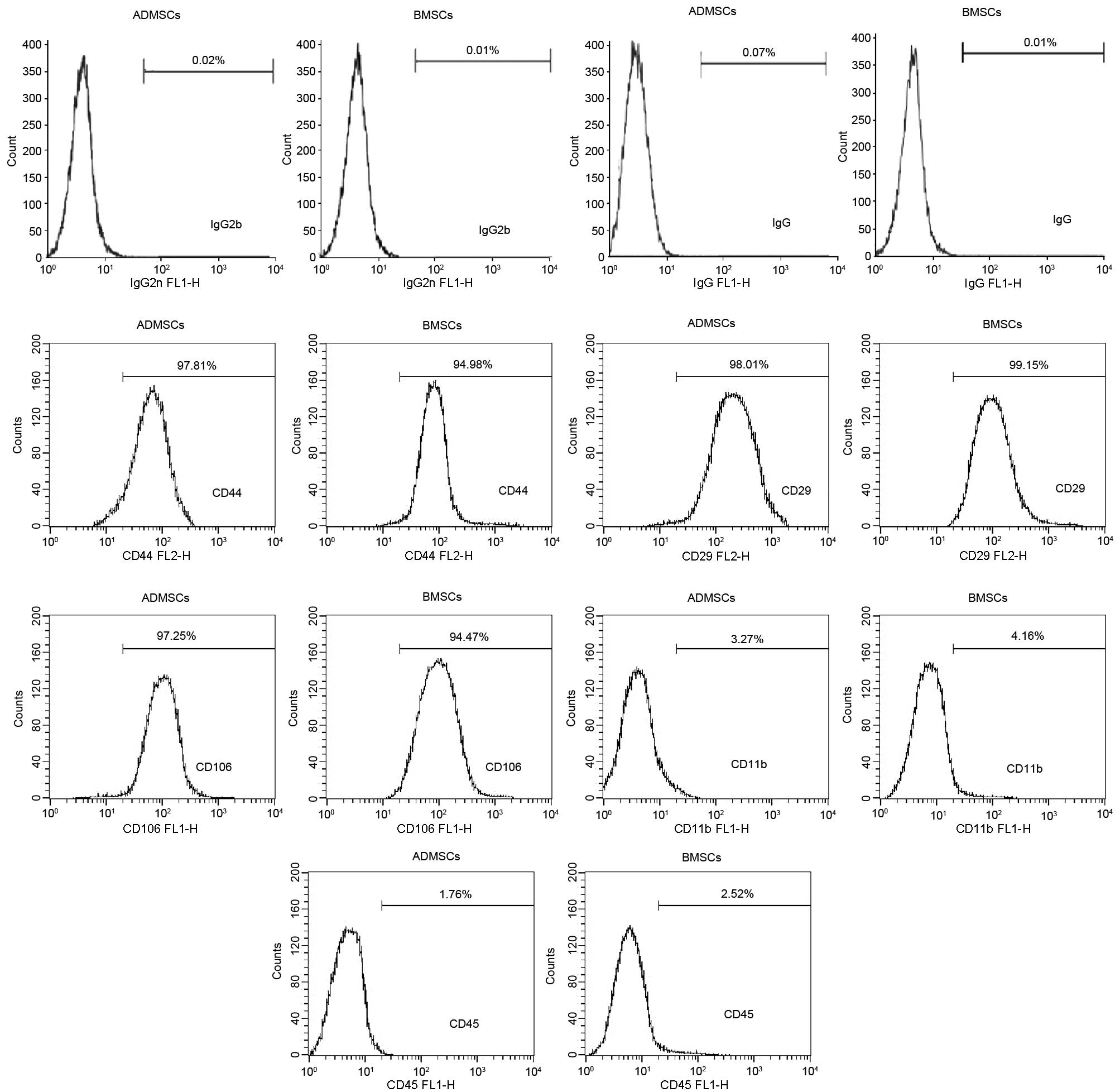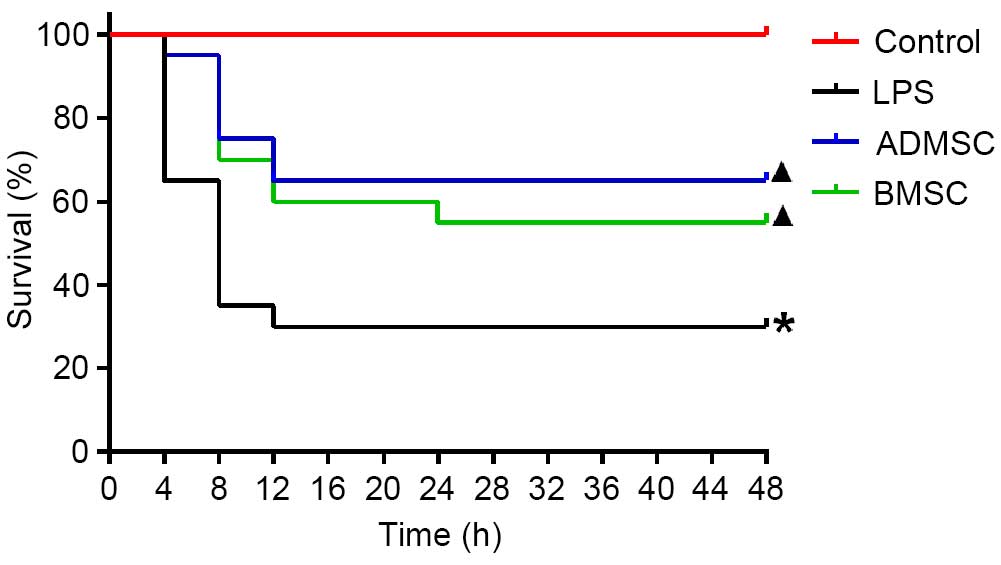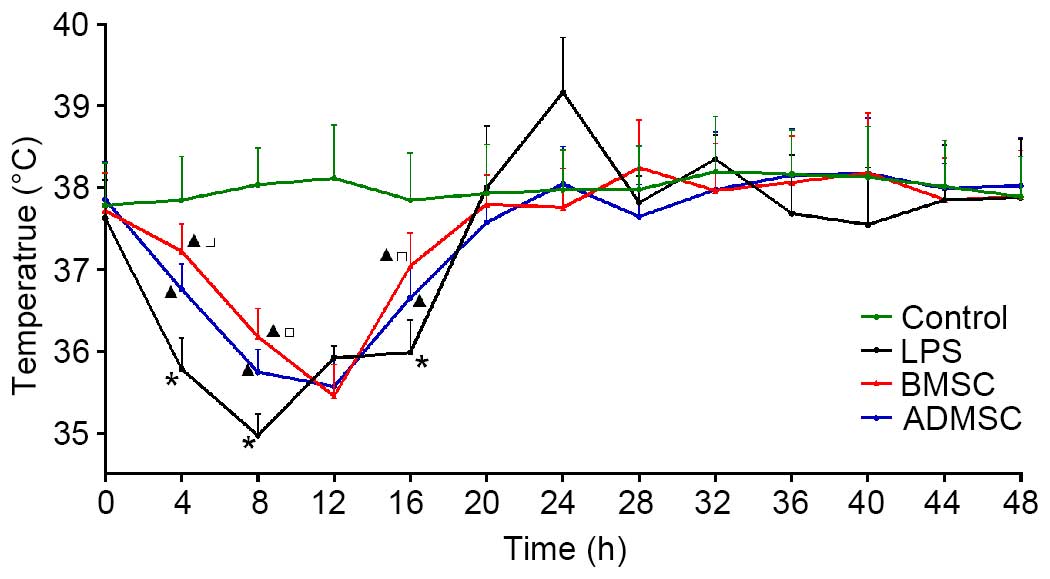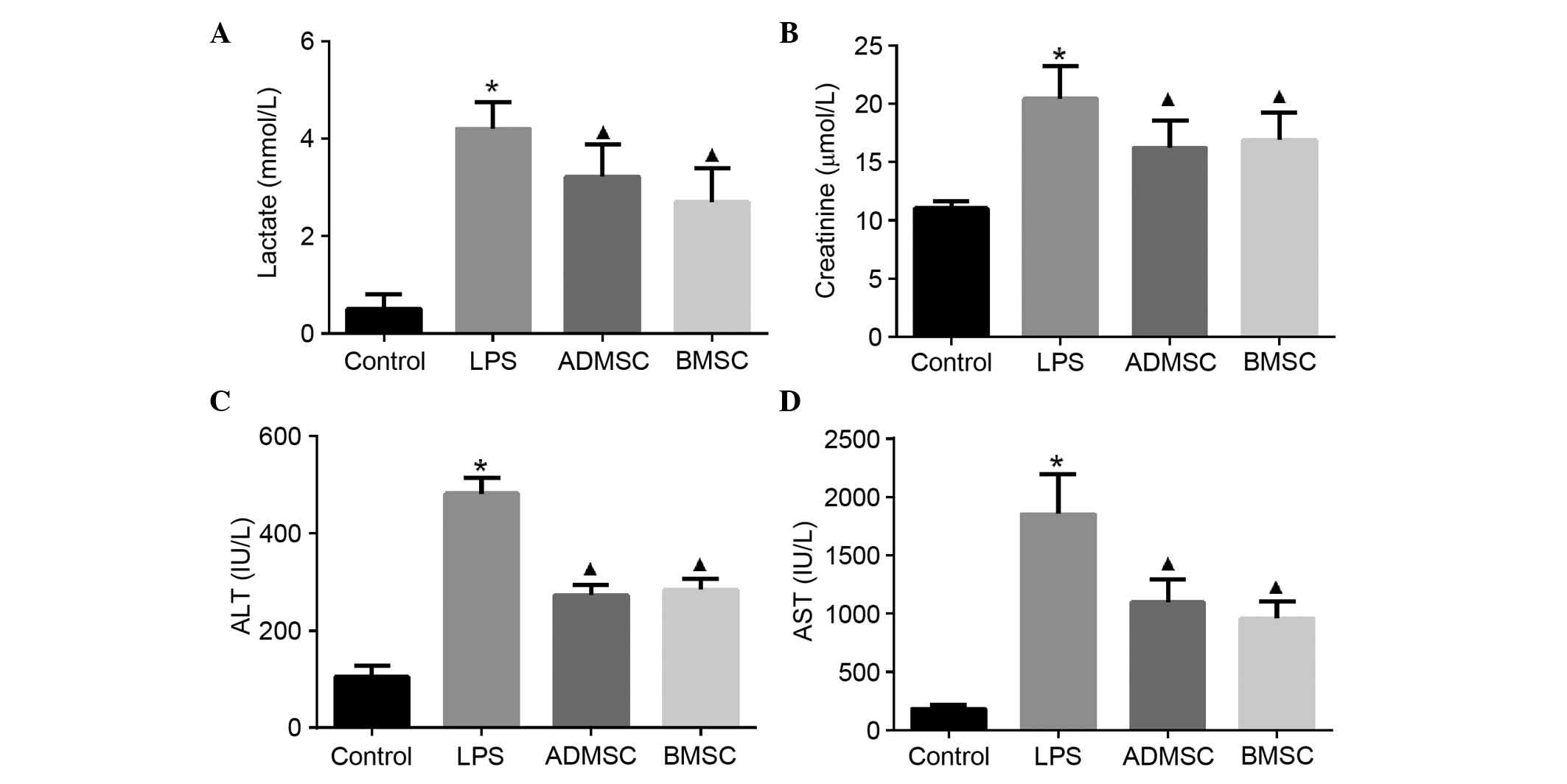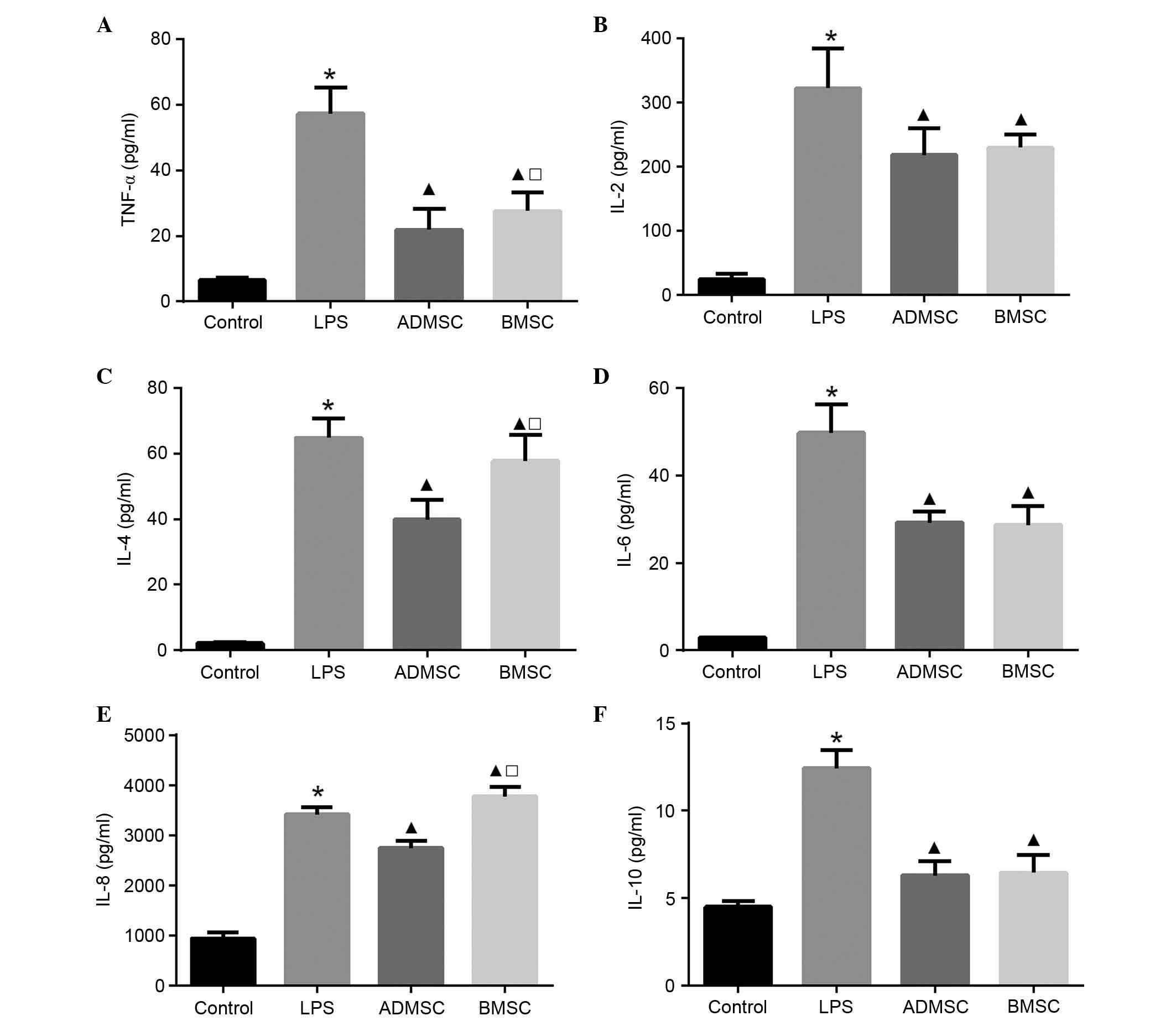Comparison of bone marrow tissue- and adipose tissue-derived mesenchymal stem cells in the treatment of sepsis in a murine model of lipopolysaccharide-induced sepsis
- Authors:
- Published online on: August 30, 2016 https://doi.org/10.3892/mmr.2016.5694
- Pages: 3862-3870
Abstract
Introduction
Sepsis, which has been described as the response of the host towards invading pathogens or their toxins, remains a leading contributor to mortality rates in critically ill patients (1–3). Previous reports have indicated that this condition is occurring in increasing numbers of patients, with the mortality rate within 48 h of admission to an intensive care unit reaching 49.8% (4,5). There has been no marked reduction in long-term mortality rates, despite advances in monitoring devices, diagnostic tools and therapeutic strategies (6–8). In this regard, novel effective therapeutic strategies for the treatment of sepsis are in urgent demand.
The inflammatory response in sepsis is particularly complex and is characterized by an imbalance in the cytokine profile (9). It has been suggested that sepsis is associated with an exacerbated release of pro-inflammatory cytokines, including tumor necrosis factor (TNF)-α and interleukin (IL)-6 (10–12), and these cytokines serve as markers of disease severity in sepsis (13). Evidence also indicates that the increase of pro-inflammatory cytokines is accompanied by certain anti-inflammatory cytokines, including IL-10 (14). In this context, interventions aiming at restoring the balance in the cytokine network may be promising.
Mesenchymal stem cells (MSCs) are reported to have immunomodulatory properties, and have emerged as a promising tool for the treatment of sepsis. In previous years, the administration of bone marrow-derived MSCs (BMSCs) has been shown to attenuate sepsis-associated inflammation and multiple organ dysfunctions, thereby improving survival rates in experimental sepsis (15–18). Further evidence has suggested that MSC treatment reduces the levels of pro-inflammatory cytokines, including TNF-α and IL-6, accompanied by increased levels of the anti-inflammatory cytokine, IL-10, which may counteract the marked pro-inflammatory response and restore immunological equilibrium (13,17,18). However, others have reported either no effect on the levels of IL-10 or reported a reduction (15,19,20). The beneficial effect of MSCs on sepsis may be associated with the precise regulation targeted at different immunological statuses in models of sepsis.
MSCs are non-hematopoietic precursor cells derived from a variety of tissues, including bone marrow, adipose tissue, the placenta and umbilical cord (21). BMSCs were initially considered the primary source of MSCs for clinical application, and the protective effect of BMSCs on sepsis has been demonstrated (17). However, bone marrow harvesting is invasive and painful, and can be associated with donor-site morbidity with potentially low cell yields (22). Compared with BMSCs, adipose tissue-derived MSCs (ADMSCs) can be more readily obtained, isolated and rapidly expanded in vitro to generate sufficient dosages (23,24). Therefore, ADMSCs have been investigated as an alternative to BMSCs in several animal models of incurable disease (25,26).
Although it has been demonstrated that ADMSCs offer protective effects against inflammation-associated injury (27), whether ADMSCs exhibit an identical effect to BMSCs due to use of a different model remains to be elucidated. In addition, MSCs derived from different sources may exhibit different immunological characteristics and therapeutic effects (28,29). Therefore, further investigations are required to compare the effect of BMSC and ADMSC on dysfunction and systemic inflammation in the same disease model. The present study aimed to compare the therapeutic effect of BMSCs and ADMSCs in a mouse model of lipopolysaccharide (LPS)-induced sepsis, and examine their potential regulatory role on pro- and anti-inflammatory cytokines underlying the sepsis-associated inflammatory response.
Materials and methods
Animals
SPF BALB/c mice, provided by the Animal Experiment Center of The Third Xiangya Hospital of Central South University (Changsha, China) were used in the present study. The mice were fed a standard diet and placed in isolation in the animal facility at the Third Xiangya Hospital of Central South University, for acclimation purposes, for 1 week prior to experimentation. The mice were maintained at a 20–260°C, a relative humidity of 40–70% and 12 h light/dark cycles. All experimental protocols were approved by the ethics committee of the Third Xiangya Hospital of Central South University (2012S130).
BMSC isolation and culture
The BALB/c mice, weighing 12–22 g (4 weeks old; n=5), were sacrificed by cervical dislocation. Following immersion in 75% ethanol for 10 min, the femurs and tibiae of the mice were removed and placed on a sterile glass platform. The ends of each femur and tibia, just below the end of the marrow cavity, were cut and the marrow was flushed out with phosphate-buffered saline (PBS; GE Healthcare Life Sciences, Logan, UT, USA), followed by centrifugation at 300 × g for 5 min at room temperature to remove blood and unnecessary tissue (30). The cell pellet was then resuspended with 5 ml of red blood cell lysis buffer (Sigma-Aldrich; Thermo Fisher Scientific, Inc., Waltham, MA, USA). Following centrifugation at as before, the cells were resuspended in 5 ml of complete medium comprised of Dulbecco's modified Eagle's medium (DMEM)/F12 (GE Healthcare Life Sciences) supplemented with 10% fetal bovine serum (Gibco; Thermo Fisher Scientific, Inc.) and 1% penicillin-streptomycin. All cells were plated in a 25-cm2 cell culture flask (Greiner Bio-One GmbH, Frickenhausen, Germany) and incubated at 37°C in 5% humidified CO2. After 48 h, the non-adherent cells were discarded and the adherent cells were washed twice with PBS. Fresh complete medium was then added and replaced every 3 days. After 14 days of initiating culture, the cells were washed with PBS and lifted by incubation in 0.5 ml of 0.25% trypsin/1 mM EDTA (Gibco; Thermo Fisher Scientific, Inc.) for ~1 min at 37°C [20]. Complete medium (~1.5 ml) was then mixed with the cells to neutralize the trypsin, following which the cells were centrifuged at as before and resuspended in 15 ml of complete medium. The cells were passaged at a split ratio of 1:3 and cultured in 25-cm2 cell culture flasks, with culture medium replaced every 3 days (31). Cells in the third passage were used for subsequent experimentation.
ADMSC isolation and culture
BALB/c mice weighing 12–22 g (4 weeks old; n=5) were sacrificed by cervical dislocation and immersed in 75% ethanol for 10 min. Lumbar dorsal adipose tissue was then isolated and minced into 1–2-mm3 fragments. The tissue was then digested in a 10-ml centrifuge cube containing 5 ml 0.1% collagenase I (Sigma-Aldrich; Thermo Fisher Scientific, Inc.) for 1 h in a shaking incubator at 37°C and at a speed of 300 × g (32). Following centrifugation at 300 × g for 5 min at room temperature, the cells were resuspended in 5 ml of complete medium and seeded into a 25-cm2 cell culture flask prior to culture in an incubator at 37°C with 5% humidified CO2 for 48 h. The subsequent steps were identical to those for the BMSCs described above.
Phenotypic characterization of MSCs
The cells were harvested by trypsinization, as described above, washed in cold PBS (4–8°C) and centrifuged for 5 min at 300 × g at room temperature. The cells (1×106) were then suspended in 1 ml of cold PBS per tube, and stained with fluorescein isothiocyanate (FITC)-conjugated anti-mouse CD11b, CD45 and CD106; phycoerythrin (PE)-conjugated anti-mouse CD44 and CD29 (eBioscience, Inc., San Diego, CA, USA). The numbers of cells were determined using a blood-cell counting chamber (Hausser Scientific, Horsham, PA, USA). For the isotype controls, FITC- or PE-conjugated non-specific rat and mouse IgG (eBioscience, Inc.) was substituted for the primary antibody. Details of the antibodies used for flow cytometry are shown in Table I. The cells were incubated with the antibodies for 45 min at 4°C in the dark, followed by washing in PBS and resuspension in 1 ml PBS prior to examination using a FACSJazz flow cytometer (BD Biosciences, Franklin Lakes, NJ, USA).
MSC multilineage differentiation potential
The confluent BMSCs and ADMSCs were assessed for their multi-lineage differentiation potential using standardized protocols from Cyagen Biosciences, Inc. (Guangzhou, China). Non-differentiated stained cells were used for comparison.
For chondrogenic differentiation, the MSCs (1×106) were suspended in 1 ml of complete chondrogenic medium (Cyagen Biosciences, Inc.). Following centrifugation at 300 × g for 5 min at room temperature, the cells were incubated at 37°C in a humidified atmosphere of 5% CO2 with the tube caps loosened by one half turn. The medium was replaced every 3 days. The chondrogenic pellets were harvested following culture for 28 days. For examinations using microscopy, the pellets were formalin-fixed and paraffin-embedded prior to Alcian blue staining (Sigma-Aldrich; Thermo Fisher Scientific, Inc.).
For osteogenic differentiation, the MSCs were seeded into 6-well tissue culture plates, which were pre-coated with gelatin solution, at a density of 3×103 cells/cm2 in complete medium, and cultured at 37°C in 5% CO2 for 7 days. The medium was then replaced with osteogenic induction medium (Cyagen Biosciences, Inc.) for an additional 21 days. The medium was replaced every 3–4 days. Following 3 weeks of differentiation, the cells were formalin-fixed and stained with Alizarin red (Sigma-Aldrich; Thermo FIsher Scientific, Inc.).
For adipogenic differentiation, the MSCs were seeded into 6-well tissue culture plates at a density of 2×104 cells/cm2 in complete medium, and were cultured at 37°C in 5% CO2. The cells were maintained by replacing the complete medium every 3 days until a confluent cell layer was formed. The cells were then stimulated to differentiate into the adipogenic lineage by exposing the cells to three cycles of altering culture in adipogenic induction medium (Cyagen Biosciences, Inc.) and maintenance medium (Cyagen Biosciences, Inc.) according to the manufacturer's protocol. At the end of these cycles, the cells were grown for another 7 days by replacing the maintenance medium every 3 days. To verify adipogenic differentiation, the cells were fixed with 4% formaldehyde solution for 30 min and stained with oil red O (Sigma-Aldrich; Thermo Fisher Scientific, Inc.). Following all staining procedures, images were captured and analyzed using a an inverted system microscope (Olympus, Tokyo, Japan) and were assessed using IX2-BSW Ver 01.07a software.
Preparation of the murine model of LPS-induced sepsis
SPF BALB/c mice weighing 22–28 g (8–12 weeks old; n=120) were used for the model of LPS-induced sepsis. The mice were induced with an injection of LPS (10 mg/kg, 1 mg/ml) extracted from Escherichia coli (0127:B8; Sigma-Aldrich; Thermo Fisher Scientific, Inc.) via the tail vein. A sham intervention was performed using saline (10 mg/kg) in the control mice. To compare the effect of MSCs on the septic mice, either saline (10 mg/kg), BMSCs (1×107/ml; 100 µl) or ADMSCs (1×107/ml; 100 µl) were injected via the tail vein 5 min following administering LPS.
Survival analysis following LPS administration
For survival analysis, 80 mice were randomly divided into four groups (n=20/group): i) Saline only treatment (control group); ii) LPS + saline treatment (LPS group); iii) LPS + BMSC treatment (BMSC group), iv) LPS + ADMSC treatment (ADMSC group). The mice were monitored for 48 h and the survival rates were recorded. The rectal temperatures of the mice were also measured every 4 h post-LPS administration.
Determination of serum cytokines and biochemical markers
A total of 40 mice were randomly divided into the four groups described above (n=20/group). Based on the data obtained from the recording of survival rates and temperatures, serum samples were collected 6 h post-LPS administration for analysis, as no differences were observed between the four groups at this time. The mice were sacrificed under anesthesia with 10% chloral hydrate (30 mg/kg), and whole blood samples were collected from the heart. Serum samples were obtained following blood separation by centrifugation at 3,500 × g for 20 min at room temperature and were stored at −70°C until analysis. Serum levels of IL-2, IL-4, IL-6, IL-8, IL-10 and TNF-α were determined using an enzyme-linked immunosorbent assay (ELISA) with mouse-specific kits (Thermo Fisher Scientific, Inc.). Serum levels of the tissue hypoperfusion indicator, lactate, the renal dysfunction indicator, creatinine, and hepatic dysfunction indicators, alanine aminotransferase (ALT) and aspartate aminotransferase (AST), were determined using an automatic analyzer (7600-020; Hitachi, Tokyo, Japan).
Statistical analysis
Data were analyzed using the SPSS 13.0 software package (SPSS, Inc., Chicago, IL, USA) and are presented as the mean ± standard deviation. Comparisons of mean body temperature, levels of serum cytokines and biochemical markers between the four groups were made using one-way analysis of variance followed by the Bonferroni multiple-comparison post-hoc test. Survival data are presented in Kaplan-Meier curves and statistical significance was assessed using the Log rank test. P<0.05 was considered to indicate a statistically significance difference.
Results
Characterization of BMSCs and ADMSCs
The BMSCs and ADMSCs reached 90% confluence between days 5 and 7 (Fig. 1A)., and the two cell types shared several features. The MSCs from the two cell sources exhibited a spindle-shaped morphology and adhered well to the plastic culture flasks. Additionally, the MSCs from the two sources were demonstrated to differentiate into chondrocytes, osteoblasts and adipocytes (Fig. 1B–D) following culture in appropriate induction medium. Finally, the two cell types were negative for the expression of CD11b and CD45 and positive for the expression of CD44, CD106 and CD29 (Fig. 2).
MSC treatment improves survival rates following LPS induction
Survival analysis showed that all the mice in the control group survived. The overall survival rates were significantly improved in the BMSC and ADMSC groups, compared with the LPS group (P<0.05). It was observed that, of the animals that succumbed to mortality, all occurred within 24 h, with the majority (13/14 for the LPS group, 5/7 for the ADMSC group and 6/9 for the BMSC group) occurring within 8 h. Therefore, the survival rates were determined at 24 h. By 24 h, 6, 11 and 13 mice had survived in the LPS, BMSC and ADMSC groups, respectively. The survival rate was the highest in the ADMSC group (65%), followed by the BMSC group (55%), and was lowest in the LPS group (30%). The survival rates were significantly higher in the BMSC and ADMSC groups, compared with the LPS group (P<0.05). Although the survival rate was higher in the ADMSC group, compared with the BMSC group, this difference was not significant (P>0.05; Fig. 3).
MSC treatment reduces body temperature fluctuations following LPS induction
To evaluate changes in body temperature, the body temperatures of the mice were recorded every 4 h within the 48 h period following LPS exposure. With the exception of the control group, the mice in the remaining three groups exhibited a decrease in mean body temperature within 16 h. The temperature reached the nadir at 8 h in the LPS group, and at 12 h in the two MSC treatment groups. The body temperature was significantly lower in the LSP group, compared with the MSC treatment groups, and significantly higher in the BMSC group, compared with the ADMSC group at 4, 8 and 16 h (P<0.05). By 24 h, the temperature in the LPS group was significantly higher, compared with those in the other three groups (P<0.05). These results showed that MSC administration attenuated the temperature decline, and ADMSCs appeared to be more effective than BMSCs (Fig. 4).
MSC treatment attenuates organ damage following LPS induction
As sepsis is life-threatening due to being associated with organ failure, biochemical markers of the major organs often injured in humans were examined to determine whether MSCs had a beneficial effect on organ dysfunction. The serum levels of lactate, creatinine, ALT and AST were measured 6 h following LPS exposure. These markers were significantly increased in the mice with LPS-induced sepsis, compared with the mice in the control group. The concentrations of serum lactate, creatinine and liver enzymes, including ALT and AST, which are released into the circulation upon injury, were significantly decreased in the MSC-treated mice, compared with mice in the LPS group (P<0.05). However, no significant differences were found in the concentrations of these biochemical markers between the BMSC and ADMSC groups (P>0.05; Fig. 5).
Effect of MSCs on serum cytokine concentrations
To examine the serum levels of pro- and anti-inflammatory cytokines, ELISA was performed 6 h post-LPS exposure. The serum concentrations of all cytokines in the LPS group were significantly increased, compared with those in the control group (P<0.05). The serum levels of TNF-α, IL-2, IL-6 and IL-10 were significantly lower, whereas the level of IL-8 was significantly higher in the BMSC group, compared with the LPS group (P<0.05). The serum levels of TNF-α, IL-2, IL-4, IL-6, IL-8 and IL-10 were significantly lower in the ADMSC group, compared with the LPS group (P<0.05). Of note, the levels of TNF-α, IL-4 and IL-8 were significantly higher in the BMSC group, compared with the ADMSC group (P<0.05). In terms of the three remaining cytokines (IL-2, IL-6 and IL-10), although their levels were higher in the BMSC group compared with the ADMSC group, this result was not significant (P>0.05; Fig. 6).
Discussion
The present study focused on the therapeutic potential and differences between two types of MSCs, BMSCs and ADMSCs, in a murine model of LPS-induced sepsis. The data demonstrated that the intravenous injection of BMSCs or ADMSCs improved animal survival rates, and alleviated temperature fluctuations and moderate multiple organ damage accompanied with a reduction in the production of the majority of pro- and anti-inflammatory cytokines. In addition, compared with the BMSCs, the ADMSCs reduced, rather than increased the serum levels of IL-8, and it appeared more potent at alleviating hypothermia in LPS-induced sepsis.
The morality rate observed in the LPS group was similar to that reported in a previous study (33). MSC treatment significantly improved the survival rates of the mice from 30 to ≥55% at 24 h post-LPS exposure. Additionally, the mice in the LPS group developed severe hypothermia between 4 and 12 h post-LPS exposure, during which time the majority of the mice succumbed to mortality. Hypothermia is reported to be associated with increased mortality rates, septic shock and organ failure in patients with severe sepsis (34,35), and is therefore considered a marker of severe illness and poor prognosis. In a cecal ligation and puncture model of sepsis, Granger et al (36) also found that body temperature was significantly reduced in the first few hours prior to increasing. Consistent with this previous study, the data obtained in the present study showed the same trend. By 8 h, the majority of the mice in the LPS group had developed severe hypothermia. However, the mice treated with MSCs exhibited a less marked decrease in their body temperature and the nadir was delayed to 12 h, suggesting that MSCs may assist in alleviating sepsis.
A substantial increase in serum concentrations of lactate, ALT, AST and creatine was observed in the mice with LPS-induced sepsis, indicating that multiple organ injuries or dysfunction had developed. This was also confirmed in previous studies (16,37). The data obtained in the present study suggested that there was a reduction in organ damage when treated with MSCs, despite the MSC sources differing.
Previous evidence suggests that an independent response pattern, a mixed antagonist response, exists at the onset of sepsis, which encompasses signs of hyperinflammation and immunosuppression (38,39). Consistent with a previous study (40), the results of the present study demonstrated a concomitant increase in the serum levels of TNF-α, IL-6 and IL-10, typical cytokines in inflammatory and anti-inflammatory responses, in the murine model of sepsis, suggestive of the existence of a mixed antagonist response. A tightly regulated balance in the cytokine network is crucial for eliminating invading pathogens and limiting the excessive tissue damage caused by inflammation (41). Of note, the results of the present study showed that MSC treatment reduced not only the serum levels of pro-inflammatory cytokines, including TNF-α and IL-6, but also anti-inflammatory cytokines, including IL-2 and IL-10. These results suggested that MSCs regulated pro- and anti-inflammatory responses. Therefore, MSCs may regulate the disturbance of homeostasis by affecting the cytokine network, which may further alleviate the injury to organ function caused by an excessive inflammatory response and the proliferation of infection resulting from the overwhelming anti-inflammatory response. This may contribute to the beneficial role of MSCs on sepsis in the model in the present study.
Compared with the LPS group, the serum levels of IL-8 were significantly increased in the BMSC group, however, they were significantly decreased in the ADMSC group. IL-8 appears to be important in the chemotaxis and activation of immune cells (42), and is reported to be closely associated with neutrophilic infiltration, which is fundamental in the pathogenesis and progression of sepsis (43–45). The serum level of IL-8 was increased in the mice treated with BMSCs, suggesting that BMSCs may enhance the migration of neutrophils to the site of inflammation, thus promoting the clearance of microbial pathogens. However, this excessive increase in neutrophil recruitment may cause severe oxidative stress injury (46). ADMSC treatment appeared to alleviate this effect by lowering the serum level of IL-8. Again, further investigation is required to confirm the role of MSCs on the levels of IL-8 and neutrophils.
Several limitations of the present study must be considered when interpreting the findings. First, the LPS-induced sepsis animal model, in which septic mice showed transient injury, cannot not completely reflect septic conditions in humans. Second, the timing of exogenous stem cell infusion following injury may be important, however, the optimal time point has not yet been established. Consequently, future investigations are required to examine the effects of administering BMSCs and ADMSCs at different time points following the induction of sepsis. Thirdly, injection with different doses of LPS led to different levels of severity in the sepsis mode used, therefore, the effect and mechanism of MSCs may differ with respect to the severity of sepsis. Further investigations are required to examine effects of administering MSCs at different time points on the survival rates, organ function and systemic inflammatory response in models of sepsis with varying severities. Furthermore, the levels of the cytokines, ALT, AST and creatinine were only measured 6 h post-LPS administration. Dynamic observation of these factors at different time points may be required to fully understand the mechanism. Further investigations are required to determine the changes of these factors during the development of sepsis.
In conclusion, the present study suggested that BMSCs and ADMSCs have similar roles in the regulation of inflammation, reducing organ injury and mortality rates in mice with sepsis. One difference identified between the BMSCs and ADMSCs was that the serum levels of IL-8 were increased and decreased, respectively. The present comparitive study also indicated that ADMSCs were more potent than BMSCs in alleviating LPS-induced sepsis. Therefore, BMSCs and ADMSCs may serve as novel treatment modalities for sepsis.
Acknowledgments
This study was supported by the Science and Technology Project of Hunan Province, China (grant nos. 2012FJ4313 and 2013WK2009) and the Natural Science Foundation of Hunan Province, China (grant no. 13JJ6019).
References
|
ARISE; ANZICS APD Management Committee: The outcome of patients with sepsis and septic shock presenting to emergency departments in Australia and New Zealand. Crit Care Resusc. 9:8–18. 2007.PubMed/NCBI | |
|
Kumar G, Kumar N, Taneja A, Kaleekal T, Tarima S, McGinley E, Jimenez E, Mohan A, Khan RA, Whittle J, et al: Nationwide trends of severe sepsis in the 21st century (2000–2007). Chest. 140:1223–1231. 2011. View Article : Google Scholar : PubMed/NCBI | |
|
Hartman ME, Linde-Zwirble WT, Angus DC and Watson RS: Trends in the epidemiology of pediatric severe sepsis*. Pediatr Crit Care Med. 14:686–693. 2013. View Article : Google Scholar : PubMed/NCBI | |
|
Lagu T, Rothberg MB, Shieh MS, Pekow PS, Steingrub JS and Lindenauer PK: Hospitalizations, costs, and outcomes of severe sepsis in the United States 2003 to 2007. Crit Care Med. 40:754–761. 2012. View Article : Google Scholar | |
|
Sakr Y, Elia C, Mascia L, Barberis B, Cardellino S, Livigni S, Fiore G, Filippini C and Ranieri VM: Epidemiology and outcome of sepsis syndromes in Italian ICUs: A muticentre, observational cohort study in the region of Piedmont. Minerva Anestesiol. 79:993–1002. 2013.PubMed/NCBI | |
|
Caironi P, Tognoni G, Masson S, Fumagalli R, Pesenti A, Romero M, Fanizza C, Caspani L, Faenza S, Grasselli G, et al: Albumin replacement in patients with severe sepsis or septic shock. N Engl J Med. 370:1412–1421. 2014. View Article : Google Scholar : PubMed/NCBI | |
|
ProCESS Investigators; Yealy DM, Kellum JA, Huang DT, Barnato AE, Weissfeld LA, Pike F, Terndrup T, Wang HE, Hou PC, et al: A randomized trial of protocol-based care for early septic shock. N Engl J Med. 370:1683–1693. 2014. View Article : Google Scholar : PubMed/NCBI | |
|
Mitka M: Drug for severe sepsis is withdrawn from market, fails to reduce mortality. JAMA. 306:2439–2440. 2011.PubMed/NCBI | |
|
Schulte W, Bernhagen J and Bucala R: Cytokines in sepsis: Potent immunoregulators and potential therapeutic targets-an updated view. Mediators Inflamm. 2013:1659742013. View Article : Google Scholar | |
|
Shahkar L, Keshtkar A, Mirfazeli A, Ahani A and Roshandel G: The role of IL-6 for predicting neonatal sepsis: A systematic review and meta-analysis. Iran J Pediatr. 21:411–417. 2011. | |
|
Schrag B, Roux-Lombard P, Schneiter D, Vaucher P, Mangin P and Palmiere C: Evaluation of C-reactive protein, procalcitonin, tumor necrosis factor alpha, interleukin-6, and interleukin-8 as diagnostic parameters in sepsis-related fatalities. Int J Legal Med. 126:505–512. 2012. View Article : Google Scholar | |
|
Song R, Kim J, Yu D, Park C and Park J: Kinetics of IL-6 and TNF-α changes in a canine model of sepsis induced by endotoxin. Vet Immunol Immunopathol. 146:143–149. 2012. View Article : Google Scholar : PubMed/NCBI | |
|
Bozza FA, Salluh JI, Japiassu AM, Soares M, Assis EF, Gomes RN, Bozza MT, Castro-Faria-Neto HC and Bozza PT: Cytokine profiles as markers of disease severity in sepsis: A multiplex analysis. Crit Care. 11:R492007. View Article : Google Scholar : PubMed/NCBI | |
|
Chuang TY, Chang HT, Chung KP, Cheng HS, Liu CY, Liu YC, Huang HH, Chou TC, Chang BL, Lee MR, et al: High levels of serum macrophage migration inhibitory factor and interleukin 10 are associated with a rapidly fatal outcome in patients with severe sepsis. Int J Infect Dis. 20:13–17. 2014. View Article : Google Scholar : PubMed/NCBI | |
|
Mei SH, Haitsma JJ, Dos Santos CC, Deng Y, Lai PF, Slutsky AS, Liles WC and Stewart DJ: Mesenchymal stem cells reduce inflammation while enhancing bacterial clearance and improving survival in sepsis. Am J Respir Crit Care Med. 182:1047–1057. 2010. View Article : Google Scholar : PubMed/NCBI | |
|
Nemeth K, Leelahavanichkul A, Yuen PS, Mayer B, Parmelee A, Doi K, Robey PG, Leelahavanichkul K, Koller BH, Brown JM, et al: Bone marrow stromal cells attenuate sepsis via prostaglandin E(2)-dependent reprogramming of host macrophages to increase their interleukin-10 production. Nat Med. 15:42–49. 2009. View Article : Google Scholar | |
|
Gupta N, Su X, Popov B, Lee JW, Serikov V and Matthay MA: Intrapulmonary delivery of bone marrow-derived mesenchymal stem cells improves survival and attenuates endotoxin-induced acute lung injury in mice. J Immunol. 179:1855–1863. 2007. View Article : Google Scholar : PubMed/NCBI | |
|
Xu J, Qu J, Cao L, Sai Y, Chen C, He L and Yu L: Mesenchymal stem cell-based angiopoietin-1 gene therapy for acute lung injury induced by lipopolysaccharide in mice. J Pathol. 214:472–481. 2008. View Article : Google Scholar : PubMed/NCBI | |
|
Krasnodembskaya A, Samarani G, Song Y, Zhuo H, Su X, Lee JW, Gupta N, Petrini M and Matthay MA: Human mesenchymal stem cells reduce mortality and bacteremia in gram-negative sepsis in mice in part by enhancing the phagocytic activity of blood monocytes. Am J Physiol Lung Cell Mol Physiol. 302:L1003–L1013. 2012. View Article : Google Scholar : PubMed/NCBI | |
|
Sepúlveda JC, Tomé M, Fernández ME, Delgado M, Campisi J, Bernad A and González MA: Cell senescence abrogates the therapeutic potential of human mesenchymal stem cells in the lethal endotoxemia model. Stem Cells. 32:1865–1877. 2014. View Article : Google Scholar : PubMed/NCBI | |
|
in't Anker PS, Noort WA, Scherjon SA, Kleijburg-van der Keur C, Kruisselbrink AB, van Bezooijen RL, Beekhuizen W, Willemze R, Kanhai HH and Fibbe WE: Mesenchymal stem cells in human second-trimester bone marrow, liver, lung, and spleen exhibit a similar immunophenotype but a heterogeneous multilineage differentiation potential. Haematologica. 88:845–852. 2003. | |
|
Dmitrieva RI, Minullina IR, Bilibina AA, Tarasova OV, Anisimov SV and Zaritskey AY: Bone marrow- and subcutaneous adipose tissue-derived mesenchymal stem cells: differences and similarities. Cell Cycle. 11:377–383. 2012. View Article : Google Scholar | |
|
Zappia E, Casazza S, Pedemonte E, Benvenuto F, Bonanni I, Gerdoni E, Giunti D, Ceravolo A, Cazzanti F, Frassoni F, et al: Mesenchymal stem cells ameliorate experimental autoimmune encephalomyelitis inducing T-cell anergy. Blood. 106:1755–1761. 2005. View Article : Google Scholar : PubMed/NCBI | |
|
Zuk PA, Zhu M, Mizuno H, Huang J, Futrell JW, Katz AJ, Benhaim P, Lorenz HP and Hedrick MH: Multilineage cells from human adipose tissue: Implications for cell-based therapies. Tissue Eng. 7:211–228. 2001. View Article : Google Scholar : PubMed/NCBI | |
|
Gonzalez-Rey E, Anderson P, Gonzalez MA, Rico L, Büscher D and Delgado M: Human adult stem cells derived from adipose tissue protect against experimental colitis and sepsis. Gut. 58:929–939. 2009. View Article : Google Scholar : PubMed/NCBI | |
|
Puissant B, Barreau C, Bourin P, Clavel C, Corre J, Bousquet C, Taureau C, Cousin B, Abbal M, Laharrague P, et al: Immunomodulatory effect of human adipose tissue-derived adult stem cells: Comparison with bone marrow mesenchymal stem cells. Br J Haematol. 129:118–129. 2005. View Article : Google Scholar : PubMed/NCBI | |
|
Shin S, Kim Y, Jeong S, Hong S, Kim I, Lee W and Choi S: The therapeutic effect of human adult stem cells derived from adipose tissue in endotoxemic rat model. Int J Med Sci. 10:8–18. 2013. View Article : Google Scholar : PubMed/NCBI | |
|
Fu X, Chen Y, Xie FN, Dong P, Liu WB, Cao Y, Zhang WJ and Xiao R: Comparison of immunological characteristics of mesenchymal stem cells derived from human embryonic stem cells and bone marrow. Tissue Eng Part A. 21:616–626. 2015. View Article : Google Scholar : | |
|
Elman JS, Li M, Wang F, Gimble JM and Parekkadan B: A comparison of adipose and bone marrow-derived mesenchymal stromal cell secreted factors in the treatment of systemic inflammation. J Inflamm (Lond). 11:12014. View Article : Google Scholar | |
|
Zhao J, Wang G, Zhang H and Fu X: Isolation, cultivation, purification and identification of mice bone marrow mesenchyaml stem cells in vitro. Chin J Lab Diagn. 16:11–13. 2012.In Chinese. | |
|
Soleimani M and Nadri S: A protocol for isolation and culture of mesenchymal stem cells from mouse bone marrow. Nat Protoc. 4:102–106. 2009. View Article : Google Scholar : PubMed/NCBI | |
|
Liu S, Lei J, Li Y, Xiang P and Zhou D: Isolation, identification and biological characteristics of mouse adipose-derived stromal cells. J Sun Yat-Sen University (Medical Sciences). 33:299–304. 2012.In Chinese. | |
|
Kim SR, Ha YM, Kim YM, Park EJ, Kim JW, Park SW, Kim HJ, Chung HT and Chang KC: Ascorbic acid reduces HMGB1 secretion in lipopolysaccharide-activated RAW 264.7 cells and improves survival rate in septic mice by activation of Nrf2/HO-1 signals. Biochem Pharmacol. 95:279–289. 2015. View Article : Google Scholar : PubMed/NCBI | |
|
Kushimoto S, Gando S, Saitoh D, Mayumi T, Ogura H, Fujishima S, Araki T, Ikeda H, Kotani J, Miki Y, et al: The impact of body temperature abnormalities on the disease severity and outcome in patients with severe sepsis: An analysis from a multicenter, prospective survey of severe sepsis. Crit Care. 17:R2712013. View Article : Google Scholar : PubMed/NCBI | |
|
Tiruvoipati R, Ong K, Gangopadhyay H, Arora S, Carney I and Botha J: Hypothermia predicts mortality in critically ill elderly patients with sepsis. BMC Geriatr. 10:702010. View Article : Google Scholar : PubMed/NCBI | |
|
Granger JI, Ratti PL, Datta SC, Raymond RM and Opp MR: Sepsis-induced morbidity in mice: Effects on body temperature, body weight, cage activity, social behavior and cytokines in brain. Psychoneuroendocrinology. 38:1047–1057. 2013. View Article : Google Scholar : | |
|
Shi DW, Zhang J, Jiang HN, Tong CY, Gu GR, Ji Y, Summah H and Qu JM: LPS pretreatment ameliorates multiple organ injuries and improves survival in a murine model of polymicrobial sepsis. Inflamm Res. 60:841–849. 2011. View Article : Google Scholar : PubMed/NCBI | |
|
Novotny AR, Reim D, Assfalg V, Altmayr F, Friess HM, Emmanuel K and Holzmann B: Mixed antagonist response and sepsis severity-dependent dysbalance of pro- and anti-inflammatory responses at the onset of postoperative sepsis. Immunobiology. 217:616–621. 2012. View Article : Google Scholar | |
|
Osuchowski MF, Welch K, Siddiqui J and Remick DG: Circulating cytokine/inhibitor profiles reshape the understanding of the SIRS/CARS continuum in sepsis and predict mortality. J Immunol. 177:1967–1974. 2006. View Article : Google Scholar : PubMed/NCBI | |
|
Mei SH, McCarter SD, Deng Y, Parker CH, Liles WC and Stewart DJ: Prevention of LPS-induced acute lung injury in mice by mesenchymal stem cells overexpressing angiopoietin 1. PLoS Med. 4:e2692007. View Article : Google Scholar : PubMed/NCBI | |
|
Hack CE, Aarden LA and Thijs LG: Role of cytokines in sepsis. Adv Immunol. 66:101–195. 1997. View Article : Google Scholar : PubMed/NCBI | |
|
Hechtman DH, Cybulsky MI, Fuchs HJ, Baker JB and Gimbrone MA Jr: Intravascular IL-8. Inhibitor of polymorpho-nuclear leukocyte accumulation at sites of acute inflammation. J Immunol. 147:883–892. 1991.PubMed/NCBI | |
|
Collins PD, Jose PJ and Williams TJ: The sequential generation of neutrophil chemoattractant proteins in acute inflammation in the rabbit in vivo. Relationship between C5a and proteins with the characteristics of IL-8/neutrophil-activating protein 1. J Immunol. 146:677–684. 1991.PubMed/NCBI | |
|
Chen HC, Lin HC, Liu CY, Wang CH, Hwang T, Huang TT, Lin CH and Kuo HP: Neutrophil elastase induces IL-8 synthesis by lung epithelial cells via the mitogen-activated protein kinase pathway. J Biomed Sci. 11:49–58. 2004. View Article : Google Scholar : PubMed/NCBI | |
|
Harada A, Sekido N, Akahoshi T, Wada T, Mukaida N and Matsushima K: Essential involvement of interleukin-8 (IL-8) in acute inflammation. J Leukoc Biol. 56:559–564. 1994.PubMed/NCBI | |
|
Ramaiah SK and Jaeschke H: Role of neutrophils in the pathogenesis of acute inflammatory liver injury. Toxicol Pathol. 35:757–766. 2007. View Article : Google Scholar : PubMed/NCBI |



